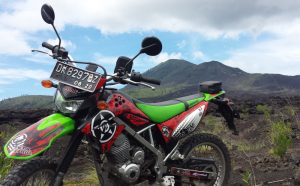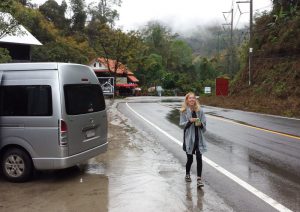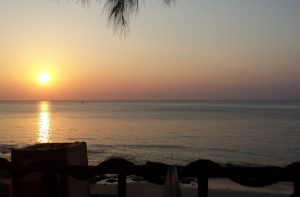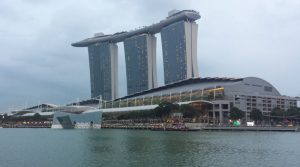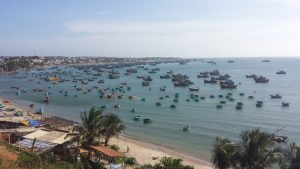The trip starts as many trips start in Asia, I need to find an excuse to rent a dirt bike. Rather than ask the people working at our hostel about the tourist destinations, I open Google Maps and look at the area surrounding Phnom Penh. After five minutes I find the International Buddhist Center. After seven minutes I’m positive that it’s worth checking out.
Joanna says it sounds cool, and we decide to make it a picnic. I go to the lobby and have the guy behind the desk summon me a dirt bike. Then we start looking for a place to get picnic food. Finding a sandwich shop in Asia is like trying to peel an onion with a chopstick, and we go through all of the brochures to find one place that looks decent. We change, then meet the dirt bike man in the lobby. He confiscates my passport in exchange for the keys, and I pay him with a crisp $20 bill.
Google Maps has given me the suggestion that the Buddhist Center isn’t that far away from our hostel. If you measure it strictly in terms of miles or kilometers, this is true. However, there was something else that was going to make this the most harrowing experience on a motorcycle that I would ever have. Something fluid like a river, loud like a hornet’s nest, and with an unpleasant aftertaste of insanity.
Don’t Mind the Sidewalk
The first twenty minutes is intense but I adjust quickly. We’re still in the city, the road resembles a road, and the traffic law atrocities being committed aren’t enough to summon the UN Peacekeepers. Our dirt bike is an older make but it’s built like a tank. It has a deep guttural exhaust sound that lets everyone know we have a full size 250cc engine. Since me and Joanna weigh no more than a single fat American, we make good time.
Driving towards the outskirts the city falls down around us. The buildings become more squat and their outsides more tarnished. Even these crusty looking apartments look nice compared to what comes next; the one room thatch houses built of materials assorted and unknown. These buildings give a good idea of how most people live in Cambodia, and I stare at them whenever I feel like I can spare a second. I think that every American who likes to complain about minor trivialities should be forced to live here for a week.
Potholes begin to appear. They give our road, ostensibly named Highway 1, the appearance of the pockmarked face of an acne afflicted teenager. In addition, the boundaries separating the road, from everything that is not the road, become a matter of interpretation. As soon as traffic begins to bunch, schools of scooters drive off onto the area where a sidewalk should be. They leave tiny rooster tails behind them as they plow through dust and gravel. Like a sardine I follow the crowd. Even with the dirt bike it’s difficult driving, and it’s a testament to the skill of the Cambodians that they’re able to handle this jarring terrain on tiny scooters with basketball sized tires.
Getting further outside of Phnom Penh, in the area that would be the suburbs in an American city, the traffic grows more gnarly. We’re forced to ride within several inches of semis and dump trucks who I assume are all piloted by sociopaths. I don’t imagine that any of these drivers would lose sleep over grinding a couple of people into the road. We’re so close that I can brush my shoulder against massive tires.
However, of more pressing concern is the engine. The only thing keeping it from boiling alive is cool air rushing past. At the moment it’s 90 degrees outside, we’re driving 10 mph in a low gear, and I can feel the heat from the gasoline explosions spreading through our seat and into my jeans. Setting aside my initial thought that these old bikes are built like Scottish fortresses, I begin to wonder how reliable they really are.
Follow the Leader
Fifteen minutes of hell and then we’re through the worst of it. The traffic has thinned from brain aneurysm to the relatively comfortable level of extremely stressful. We’re just starting to regularly reach speeds of 20mph when I feel that something isn’t right. The steering feels mushy and the engine is working overtime to maintain our speed. I look down and see that the front tire is half flat. Well past the city, we’re on a dirt highway that looks like it belongs in Africa. We have about $25, our cellphones can’t make calls, and I’m not prepared to handle this. A quarter mile down the road and the tire is done.
We get off and I’m emotionally wrecked. Driving through torrents of terrorist traffic for the last hour has left me functioning at the level of a five year old who hasn’t had his nap. I feel like throwing the dirt bike in the a ditch and drinking six beers in short succession.
Joanna takes over.
In places like Cambodia and Vietnam you’ll notice that on the side of the road, every half mile or so, there’s a small garage. We find one almost immediately and through vigorous sign language we learn that they don’t do tire repairs. However, they do let us use their cellphone. I call the English speaking guy at the rental shop, who asks where we are.
“I’m not really sure. Somewhere on Highway 1, outside Phnom Penh. We’ve been driving for an hour.”
This draws a moment of amused silence before he answers; “Tire repair your problem. You pay. Go to shop on road, You find shop, many shop there. You pay.”
“Ok” I reply, feeling uncharacteristically defeated. Joanna continues to lead. The mechanic who can’t fix a flat tire gestures for us to go across the road. Joanna bounces across first, and I stand with the dirt bike, waiting for a break in traffic. It feels like playing Frogger, but with higher stakes and less lives.
Tire Repair in Cambodia
By this point I would have followed Joanna if she walked off a cliff. I still feel emotionally whipped and I want the problem to be solved without having to think. I push the dirt bike into the shop on the other side of the road, and immediately there’s some confusion about whether they can fix the tire. They try to whisk us back onto the street, insisting they don’t do this kind of repair. We refuse to move, and insist right back that yes, whether they know it or not, they do. Coming to their senses, a young Cambodian boy puts the bike up on a stand. We get a pair of the plastic chairs that grow on trees in Asia, and sit down to watch as they begin the repair.
Having pulled the tire off and taken out the tube, the three young guys working on it locate the hole. They put a patch on the tube and then it’s time to secure it. What happens next would be to environmentalists what watching a chicken get it’s head cut off is to PETA supporters. The boys, none of whom could conceivably be a day over 18, take out a device that looks like a metal shot glass with a handle on it. One of them shakes a can, and then squirts a long stream of pitch black goo into the metal cup. Without delay another boy valiantly tries to set the rubbery black goo on fire. It refuses to light. He pours lighter fluid on it and tries again.
Success!
They use the heat generated from this ozone hazard to melt our patch on, while me and Joanna comment on tire repair in Cambodia. We’re not sure, but it seems like the type of thing that would cause an American mechanic to have a stroke.
Eating Lunch with the Kids
Environment be damned, we get the tire fixed! After half an hour the dirt bike is reassembled, and our young mechanics have crossed a month off of their lifespans by nonchalantly inhaling great deals of the black goo smoke.
“How much?” We ask, as I pull out my wallet.
One of the should-be-in-school mechanics holds up three fingers. It’s three dollars. He could have asked for five times as much and I wouldn’t have batted an eye. I give him $6. Joanna, who is several magnitudes better at languages than me, thanks them. The tire is solid and the motor has had a chance to cool. After donning our silly helmets Joanna gives me the thumbs up, and we clamber over the trench, back into no man’s land.
The next forty-five minutes go smoothly. With only minimal backtracking we find the correct artery to take us to the Buddhist Center. The road is dusty orange, the color of sunset and nuclear war. While I don’t have the ego to believe that we’re anywhere near the first Westerners to drive down this rural dirt path, I don’t believe that it’s a daily occurrence either.
Messing with Google Maps we have some difficulty finding the Buddhist Center. So when we turn a bend and find a temple, we decide to stop and have lunch. On the right side of the road is an elementary school with dozens of cheerful kids running around and screaming. We go to the other side, and walk through a set of gates that admit us onto the grounds. Beneath several large trees are some picnic tables and we sit down to eat our Fatboy subs.
In the shade, the wilting December heat feels less intense. Further into the walled off grounds are a group of young students, dressed in the traditional orange garb of monks. They look at us eating in their cafeteria and don’t seem to think much of it. I’m struck by what it must be like to grow up here. Even though we’re only about twenty or thirty miles from downtown Phnom Penh, it might as well be a thousand. I’m sure that some, if not most, of these kids have never been more than ten miles from where they’re standing right now. While the area is beautiful it’s also very antiqued. I see little that reminds me of home, and a lot that suggests that I’m in a rural part of a country that’s on the opposite side of planet from New York.
All the Buddhas
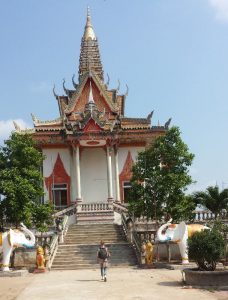 Before we leave the monk school we decide to see if we can get inside the temple. It’s one of the most ornate, beautifully carved structures I’ve ever seen, and as Joanna is walking up to it I snap a picture. Unfortunately it’s locked, and we can only guess what it must look like on the inside.
Before we leave the monk school we decide to see if we can get inside the temple. It’s one of the most ornate, beautifully carved structures I’ve ever seen, and as Joanna is walking up to it I snap a picture. Unfortunately it’s locked, and we can only guess what it must look like on the inside.
Back at the dirt bike we strap helmets onto our brains. I disengage the kill switch, push the starter and the engine explodes to life. With the phone in GPS mode we conclude that it’s only a short drive to the Buddhist Center. I’m already impressed by what we’ve seen, and I wonder how our final destination could possibly top this. In retrospect, I can see that that’s like visiting a zoo, and then wondering how Africa could be any more grand.
Following the phone, we take a left onto a one lane road and the Center begins to show on the horizon. It’s big. It’s really big. It’s what the Kremlin is to the White House: freaking gigantic! Coming to stop directly in front of it we can see that it’s actually a series of distinct buildings. Each one is about the size of a soccer field, perhaps a bit smaller. They’re several stories tall and done up in brilliant colors. While each structure has the same general outline, they’re all different on the inside. 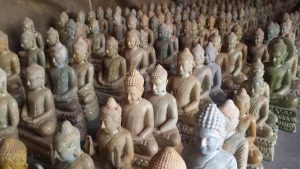 One has a large Buddha sitting beneath a roof, another has a sleeping Buddha surrounded by hundreds, if not thousands, of small Buddhas carved of stone.
One has a large Buddha sitting beneath a roof, another has a sleeping Buddha surrounded by hundreds, if not thousands, of small Buddhas carved of stone.
The first place we visit is my favorite. In the center of the enclosed court is a golden Buddha. Twenty feet tall and glowing with meaning. Sitting in front are several other statues, presumably the disciples of Buddha. The court yard is restricted by a large, intricately detailed wall. Like every Buddhist structure that I’ve seen, this wall is topped with sharp spikes shaped like horns. I still don’t know the significance of these sharp thorn projections, but I do know that they’re ubiquitous in Asia.
The Road Less Traveled
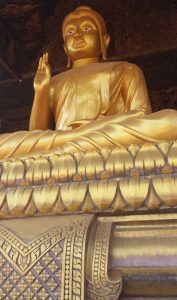 At the international Buddhist Center there are five elements instead of the usual four. Earth, wind, fire, water, and heat. As we walk further down the line of temples and shrines, I’m struck by how oppressive the heat is. It feels like a physical force that could be cut, packaged, and sold in Siberia for a profit. I feel admiration for the men and women who spent years building these incredible buildings in a pizza-oven environment.
At the international Buddhist Center there are five elements instead of the usual four. Earth, wind, fire, water, and heat. As we walk further down the line of temples and shrines, I’m struck by how oppressive the heat is. It feels like a physical force that could be cut, packaged, and sold in Siberia for a profit. I feel admiration for the men and women who spent years building these incredible buildings in a pizza-oven environment.
Coming to a building at the end of the line, we find a female monk with her young son. Joanna bows, I nod, and she bows back to Joanna. Then, before we have a chance to walk around, she signals that she’d like us to follow her. We go inside a modern looking hall, climb a few steps up onto the platform, and go through a narrow door behind the stage. We ascend one staircase, and another. Then the monk opens a set of great doors and leaves us standing in a large dome above the hall. The inside is decorated like a forest, the ceiling curves away from us, and we’re alone with our thoughts.
Out of the city, away from the usual tourist traps, we’ve manged to find something totally unique. Persistence and a sense of adventure have given us an experience that few people visiting Cambodia will ever know about. While nerve racking trips like ours are best enjoyed on an irregular basis, if you travel and only go to the most trampled spots you’ll end up missing out on a lot. Throw out the Lonely Planet guides, go to Google Maps, and create your own unique adventure! That’s what the International Buddhist Center was to us, and it was responsible for a daytime full of lasting memories that will continue for a lifetime.




